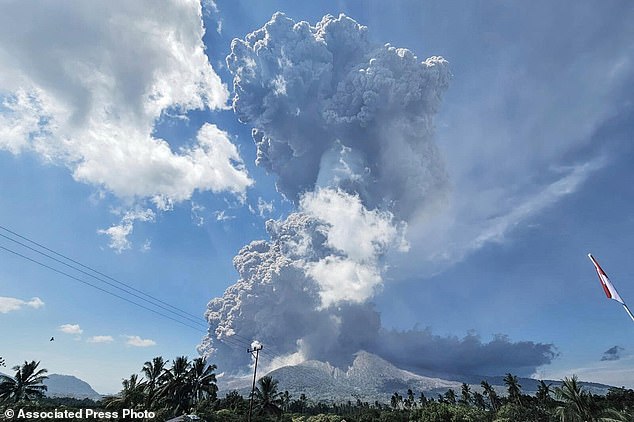
Volcanic Eruption in Indonesia Sparks Evacuations and Flight Cancellations
Mount Lewotobi Laki-Laki, a 5,197ft-high volcano located on the tourist island of Flores, has erupted again this morning. The eruption was captured in stunning footage showing a toxic ash column reaching approximately 63,000 feet into the sky. Locals recorded the event from a safe distance while authorities issued urgent warnings for people to avoid the area.
The ash cloud has spread over nearby villages, leading to the evacuation of several residents and the cancellation of multiple flights. Although volcanic clouds primarily consist of harmless water vapour, they can also release hazardous gases such as carbon dioxide, sulfur dioxide, and hydrogen sulfide. These substances pose serious risks to both human health and the environment.
Muhammad Wafid, head of Indonesia's geology agency, stated that the activity level at the volcano is currently 'very high,' characterized by explosive eruptions and continuous tremors. He advised residents to stay at least 3.7 miles (6 km) away from the volcano and to wear face masks to protect against the harmful effects of volcanic ash.
Lewotobi is a twin volcano in the southeastern part of Flores, featuring two peaks known as Lewotobi Laki-laki ('male') and Lewotobi Perempuan ('female'). The male peak, which is more active, is situated about 1.3 miles (2.1 km) northwest of its female counterpart. The latest eruption occurred on Monday at 11:05 am local time, with an ash column reaching around 18,000 meters above the summit.
The eruption was accompanied by a loud booming sound and hot clouds that traveled up to 5 km (3 miles) to the north and northeast. Fortunately, there have been no immediate reports of damage or casualties. However, officials warned of the potential for hazardous lahar floods—mixtures of water and rock fragments that can flow down the slopes of a volcano and flood nearby river valleys, posing a severe threat to communities.
Volcanic gases present in the ash cloud include:
- Water vapour – about 78%
- Carbon dioxide – about 12%
- Sulphur dioxide – about 7%
- Other gases – about 3%
Several flights from Australia to Bali, a popular tourist destination, have been affected. Carriers such as Qantas and Virgin Australia have experienced cancellations, with further delays possible depending on the movement of the ash cloud.
Bali’s Ngurah Rai international airport continued to operate normally, according to a customer service agent from InJourney Airports. However, the Indonesian transport ministry and airport operator did not immediately respond to requests for comment.
The volcano has been active for several months, with previous eruptions causing flight disruptions and evacuations. In June, dozens of flights to and from Bali were canceled after an eruption, and in November, multiple eruptions led to nine deaths and thousands of evacuations.
Monday’s eruption marks one of the largest in Indonesia since the 2010 eruption of Mount Merapi, one of the country’s most volatile volcanoes. That event killed 353 people and forced over 350,000 to evacuate.
Indonesia, located north of Australia, is an archipelago nation with a population of over 280 million. It experiences frequent seismic activity due to its location at the boundary of three major tectonic plates—the Indian-Australian, Eurasian, and Pacific plates. The country has 120 active volcanoes and lies along the 'Ring of Fire,' a region known for its high levels of seismic and volcanic activity.
Approximately 80 to 90 percent of the world’s earthquakes occur along the Ring of Fire, which stretches across the eastern US coast, Japan, and New Zealand. This geographical feature makes Indonesia particularly vulnerable to natural disasters, highlighting the importance of ongoing monitoring and preparedness efforts.
Post a Comment